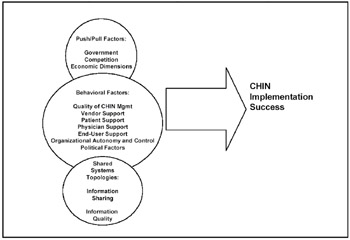Chapter XV: Data Mining in Health Care Applications
Recent attention has turned to the healthcare industry and its use of voluntary community health information network (CHIN) models for e-health and care delivery. This chapter suggests that competition, economic dimensions, political issues, and a group of enablers are the primary determinants of implementation success. Most critical to these implementations is the issue of data management and utilization. Thus, health care organizations are finding value as well as strategic applications to mining patient data, in general, and community data, in particular. While significant gains can be obtained and have been noted at the organizational level of analysis, much attention has been given to the individual, where the focal points have centered on privacy and security of patient data. While the privacy debate is a salient issue, data mining (DM) offers broader community-based gains that enable and improve healthcare forecasting, analyses, and visualization.
INTRODUCTIONIn this chapter, I provide general insight into data mining with emphasis on the health care industry. My discussion focuses on earlier electronic commerce health care initiatives, namely community health information networks (CHINs) in three regions of the United States. From my exploration of the implementation issues that impacted the success of each case, I offer Figure 1 to illustrate a cluster of factors that capture the dynamics of these live scenarios.
While my prior work (Payton & Ginzberg, 2001) focused on the information technology implementation process, here I provide insight regarding the mining of health data centered about new e-health models of care delivery. One such model for health care was the CHIN, which was a widely sought after model in the late 1990s, and continues to be widely debated by leading industry groups, such as The Healthy Cities Organization (http://www.healthycities.org/) and the IEEE-USA Medical Technology and Policy Committee (http://www.ieeeusa.org/committees/MTPC). While CHINs were said to enable multiple organizations to share health services data in order to meet common objective(s), ranging from profit maximization to improvement of public health conditions and wellness, health care organizations are now deploying e-health strategies to accomplish these goals while garnering data to address community and public health needs. Thus, health care organizations are finding value as well as strategic applications to mining patient data, in general, and community data, in particular. While significant gains can be obtained and have been noted at the organizational level of analysis, much attention has been given to the individual where the focal points have centered about privacy and security of patient data. While the privacy debate is a salient issue, data mining offers broader community-based gains that enable and improve health care forecasting, analyses, and visualization. Thus, the objectives of this chapter are:
[1]Reprinted/Adapted with Permission from Health Care Management Review, 26:2, 20 32, 2001, Aspen Publishers, Gaithersburg, MD.
| |||||||||||||||||||||||||||||||||
| | |||||||||||||||||||||||||||||||||
EAN: 2147483647
Pages: 194

